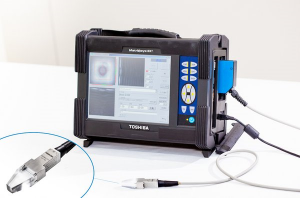Spot Welding Inspection Robots Under Development
 Strength tests on samples taken from parts consisting of 4,000-5,000 spot welds on a vehicle are an important but costly and time and labour-intensive. To help speed up the process, Toshiba is currently developing a system that allows testing to be carried out automatically by robots in a non-destructive manner.
Strength tests on samples taken from parts consisting of 4,000-5,000 spot welds on a vehicle are an important but costly and time and labour-intensive. To help speed up the process, Toshiba is currently developing a system that allows testing to be carried out automatically by robots in a non-destructive manner.
As cars have become lighter and stronger in recent years, high-strength steel sheets known as ‘high-tension materials’ are increasingly being used. The properties of these high-tension materials make it hard for chisels to be inserted and returned to normal once they are deformed. The welded spots are often destroyed in the course of inspection.
Using technology for medical use and power generation plants, Toshiba developed an ultrasonic testing device known as Matrixeye, a 3D SAFT (Synthetic Aperture Focusing technique) inspection equipment with phased array function. Matrixeye allows welds to be inspected non-destructively and inspection to be performed automatically by robots.
The challenge in non-destructive inspection technology was creating structures for automating spot welding inspections through robot control. The tilt estimation engine is a new technology that automatically adjusts the measurement angle of the inspection probe. Based on the ultrasound reflection data measured by the Matrixeye, it estimates the tilt of the welded part and then a robot automatically corrects the angle of the inspection probe. Through this, inspection time is shrunk from 30-40 seconds for human beings to approximately 7 seconds.
Toshiba is carrying out verification tests with a goal of launching the spot welding inspection technology within a year and for the technology to be adopted in other fields of manufacturing.



